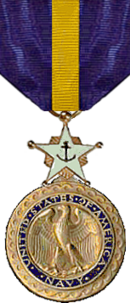Distinguished Service Medal (United States Navy)
| Navy Distinguished Service Medal | |
|---|---|

U.S. Navy Distinguished Service Medal
|
|
| Awarded by the United States Navy and the U.S. Marine Corps | |
| Type | Military medal (Decoration) |
| Awarded for | "Exceptionally meritorious service to the Government of the United States in a duty of great responsibility." |
| Status | Currently Awarded |
| Statistics | |
| Established | 4 February 1919 |
| First awarded | 13 March 1919 |
| Precedence | |
| Next (higher) | Department of Defense Distinguished Service Medal, Homeland Security Distinguished Service Medal, Department of Commerce Gold Medal |
| Equivalent | Distinguished Service Medal: Army, Air Force, Coast Guard, Public Health Service Uniformed Corps |
| Next (lower) | Silver Star Medal |
|
Service ribbon |
|
The Navy Distinguished Service Medal is a military decoration of the United States Navy and United States Marine Corps which was first created in 1919. The medal is presented to recognize distinguished and exceptionally meritorious service to the United States while serving in a duty or position of great responsibility. The award is the Navy and Marine Corps equivalent to the Army Distinguished Service Medal, the Air Force Distinguished Service Medal, and the Coast Guard Distinguished Service Medal. The Navy Distinguished Service Medal was originally senior to the Navy Cross, until August 1942 when the precedence of the two decorations was reversed. Currently, it is worn after the Defense Distinguished Service Medal and before the Silver Star Medal.
At the start of World War I, the Navy had the Medal of Honor as the only decoration with which to recognize heroism. To recognize acts deserving recognition, but at a level below that required for the Medal of Honor, the Navy Distinguished Service Medal and the Navy Cross were created by on 4 February 1919. The law made the award retroactive to 6 April 1917. The first award of the decoration was a posthumous presentation to Brigadier General Charles A. Doyen, USMC, on 13 March 1919. Originally, senior in precedence to the Navy Cross, the Navy Distinguished Service Medal assumed its current place below the Navy Cross by congressional action on 7 August 1942.
The Navy Distinguished Service Medal is bestowed upon members of the Navy or Marine Corps who distinguish themselves by exceptionally meritorious service to the United States government in a duty of great responsibility. To justify this decoration, exceptional performance of duty must be clearly above that normally expected, and contributes to the success of a major command or project. Generally, the Distinguished Service Medal is awarded to officers in principal commands at sea, or in the field, whose service is of a manner to justify the award. However, this does not preclude the award of the Navy Distinguished Service Medal to any individual who meets the service requirements. The term "great responsibility" implies senior military responsibility, and the decoration is normally only bestowed to senior Navy flag officers and Marine Corps general officers, or extremely senior enlisted positions such as the Master Chief Petty Officer of the Navy or the Sergeant Major of the Marine Corps. In rare instances, it has also been awarded to Navy captains and Marine Corps colonels, typically those in positions of significant responsibility in direct support of senior flag and general officers, and then only by exception (usually at retirement).
...
Wikipedia
